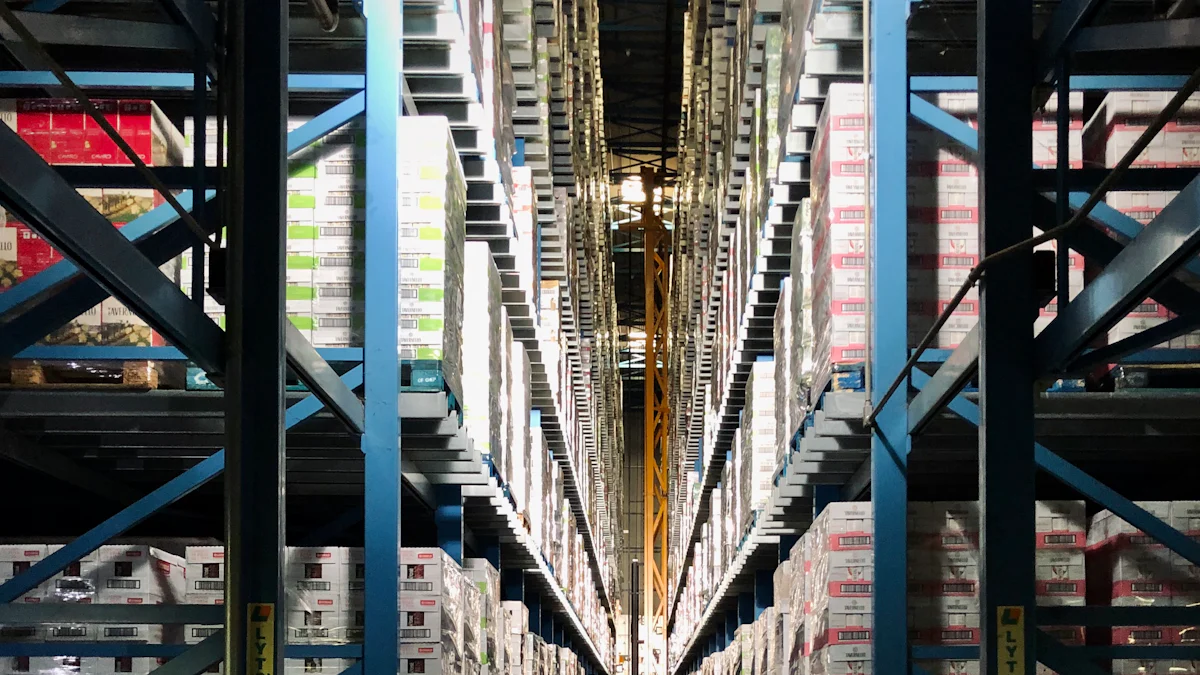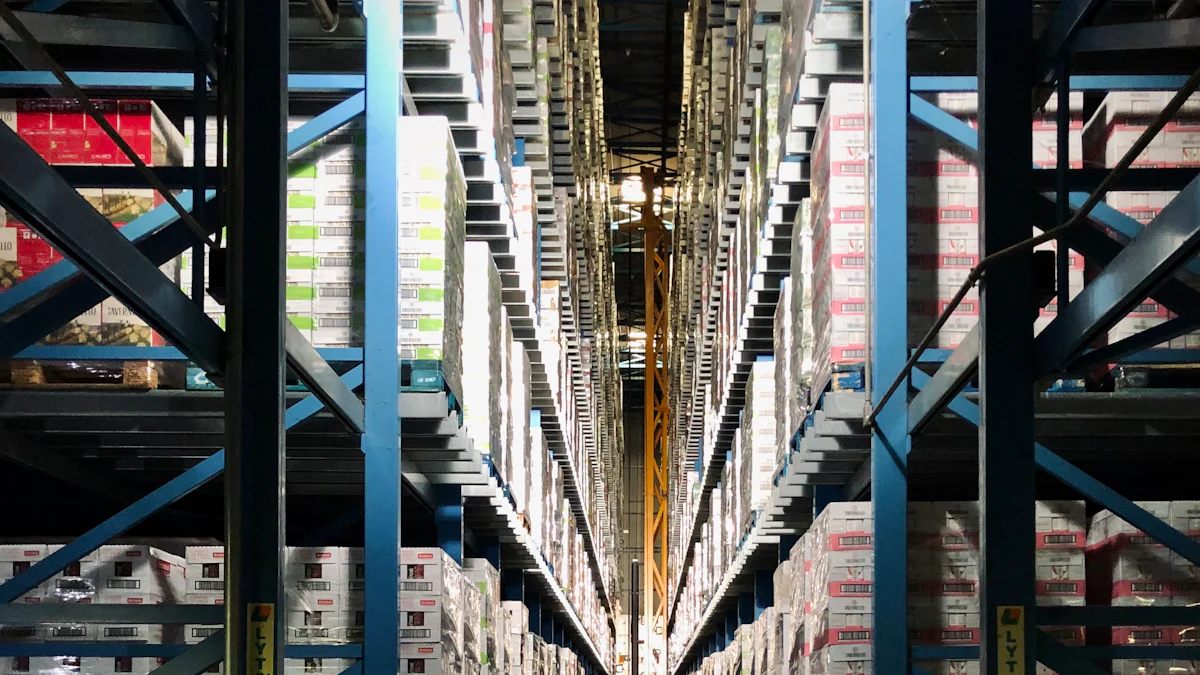Cutting Logistics Expenses: The Ultimate Guide

Efficient supply chain planning and strategic partnerships play a pivotal role in cost reduction logistics. E-commerce businesses emphasize the importance of cutting expenses to enhance profitability, foster growth, and stay competitive. Embracing innovation is key for sustainable success in the industry. As 75% of shippers acknowledge the impact of 3PL services on reducing overall costs, it's evident that technology adoption is crucial. Challenges like fluctuating fuel prices necessitate a proactive approach to achieve substantial savings.
Strategies for Cost Reduction
In the realm of cost reduction logistics, businesses are constantly seeking innovative ways to streamline their supply chain operations. By centralizing procurement processes and consolidating operations, companies can achieve significant savings and operational efficiencies.
Centralizing Procurement
Centralizing procurement involves consolidating purchasing activities under one umbrella. This strategy allows companies to leverage economies of scale, negotiate better deals with suppliers, and standardize procurement processes across different departments. By centralizing procurement, organizations can eliminate redundancies, reduce administrative costs, and enhance transparency in the purchasing process.
Consolidating Operations
Consolidating operations is another key strategy for reducing logistics expenses. By integrating various functions within the supply chain, such as warehousing, inventory management, and order fulfillment, companies can optimize workflows and minimize operational costs. This approach enables businesses to streamline processes, improve communication between different departments, and enhance overall efficiency in their operations.
Improving Transportation Efficiency
Enhancing transportation efficiency is essential for cutting logistics costs. Rationalizing carriers by selecting reliable partners based on performance metrics and service quality can lead to cost savings and improved service levels. Additionally, consolidating shipments by combining multiple orders into a single shipment reduces transportation expenses, minimizes fuel consumption, and decreases carbon emissions.
Rationalizing Carriers
Rationalizing carriers involves evaluating existing transportation providers based on key performance indicators such as on-time delivery rates, transit times, and overall reliability. By partnering with carriers that align with their business objectives and service requirements, companies can optimize transportation routes, reduce shipping costs, and enhance customer satisfaction.
Consolidating Shipments
Consolidating shipments is a strategic approach to optimizing transportation efficiency. By bundling multiple orders destined for similar locations or customers into a single shipment, businesses can maximize truckload capacity utilization and reduce per-unit shipping costs. This practice not only lowers transportation expenses but also minimizes the environmental impact associated with excessive packaging materials and vehicle emissions.
Optimizing Warehouse and Distribution Centers
Efficient inventory management is crucial for controlling logistics costs effectively. By implementing advanced inventory tracking systems, automating order fulfillment processes, and adopting lean inventory practices, companies can minimize carrying costs while ensuring product availability. Reducing travel times within warehouse facilities through layout optimization and automated picking technologies further enhances operational efficiency.
Efficient Inventory Management
Efficient inventory management involves maintaining optimal stock levels to meet customer demand while avoiding excess inventory holding costs. By utilizing real-time data analytics tools to forecast demand patterns accurately and adjust inventory replenishment strategies accordingly, businesses can prevent stockouts, reduce storage expenses, and improve order fulfillment accuracy.
Reducing Travel Times
Reducing travel times within warehouse facilities is essential for enhancing productivity and minimizing operational inefficiencies. By strategically organizing storage locations based on product popularity or order frequency, companies can shorten pick paths for workers, decrease material handling times, and increase throughput rates. Implementing automated guided vehicles (AGVs) or conveyor systems further streamlines material flow processes within distribution centers.
Case Studies:
Proven Results: Companies that centralized procurement saw a 15% reduction in purchasing costs.
Optimized Operations: Streamlining warehouse layouts led to a 20% decrease in travel distances.
Data-Driven Decisions: Leveraging real-time analytics reduced carrying costs by 10%.
Technological Solutions

In the realm of cost reduction logistics, businesses are increasingly turning to technological solutions to enhance operational efficiency and drive down expenses. Leveraging data integration through advanced software systems is a cornerstone for optimizing supply chain performance.
Leveraging Data Integration
Implementing Logistics Software and Management Systems allows companies to gain real-time visibility into inventory levels, track shipments accurately, and analyze data for informed decision-making. By utilizing IoT devices and RFID technology, organizations can streamline operations, reduce losses, and improve overall supply chain visibility.
Sales and Fulfillment Systems
Logistics Technology Solutions for Sea Freight Services offer simplified management tools that operate on an agile model, promoting scalability within operations. These systems empower businesses with efficient shipment management, inventory control capabilities, barcode integration, analytics tools, and more. By centralizing sales and fulfillment processes through these advanced systems, companies can optimize workflows, reduce errors, and enhance customer satisfaction.
Inventory Allocation
AI-driven technologies are revolutionizing inventory allocation strategies in logistics. AI and Machine Learning in Logistics enable operators to analyze vast amounts of data efficiently to identify patterns and make informed decisions. By leveraging AI algorithms for inventory allocation tasks, businesses can optimize stock levels based on demand forecasts, reduce excess inventory holding costs, and ensure timely order fulfillment.
Optimizing Last-Mile Delivery
Efficient last-mile delivery is essential for enhancing customer satisfaction while minimizing transportation costs. Utilizing AI-powered route optimization tools enables companies to plan delivery routes effectively based on real-time traffic conditions and customer preferences.
Route Optimization
By incorporating AI and Smart Scheduling into fleet management practices, businesses can optimize delivery routes dynamically. These technologies integrate diverse data sources to create efficient routing plans that minimize delays and enhance overall fleet efficiency. Through smart scheduling algorithms powered by AI capabilities, logistics operators can reduce uncertainty in delivery times while maximizing resource utilization.
Performance Analysis
Data analytics plays a crucial role in evaluating last-mile delivery performance metrics. Supply Chain Metrics derived from transportation technology solutions provide valuable insights into operational efficiency and service quality. By analyzing key performance indicators such as on-time deliveries, average travel times, and fuel consumption rates, companies can identify areas for improvement in their last-mile delivery operations.
Managing Returns and Reverse Logistics
Efficient management of returns is vital for reducing costs associated with reverse logistics processes. Implementing automated returns processing systems streamlines return handling procedures while minimizing errors.
Efficient Returns Processing
Utilizing advanced automation technologies such as Transportation Management Systems (TMS) enhances returns processing efficiency by automating return authorization workflows. These systems enable seamless coordination between warehouses, carriers, and customers during the returns process while reducing manual intervention requirements significantly.
Cost Management in Reverse Logistics
Data analytics tools play a critical role in managing costs associated with reverse logistics operations effectively. By monitoring key cost drivers such as return shipping fees, restocking expenses, and product refurbishment costs using Data Analytics, companies can implement targeted cost reduction strategies that optimize their reverse logistics processes while maintaining service quality standards.
Future Trends

Sustainable Initiatives
Eco-friendly Practices
Implementing sustainable initiatives in logistics operations is becoming increasingly crucial for businesses aiming to reduce their environmental impact while cutting costs. By adopting eco-friendly practices, companies can not only contribute to a greener planet but also achieve long-term cost benefits through efficient resource management.
Utilizing renewable energy sources such as solar or wind power for warehouse operations can significantly reduce carbon emissions and lower energy costs simultaneously.
Implementing recycling programs within distribution centers helps minimize waste generation and promotes a circular economy approach that enhances sustainability efforts.
Embracing packaging optimization strategies like using biodegradable materials or right-sizing packages reduces material consumption, lowers shipping costs, and minimizes environmental footprint.
Long-term Cost Benefits
Focusing on sustainable initiatives not only aligns with corporate social responsibility goals but also brings about substantial long-term cost benefits for businesses. By investing in environmentally friendly practices, companies can realize significant savings over time while building a positive brand image associated with sustainability.
Adopting green transportation solutions, such as electric vehicles or hybrid trucks, reduces fuel expenses, maintenance costs, and greenhouse gas emissions in the long run.
Implementing energy-efficient technologies like LED lighting systems or smart HVAC controls in warehouses leads to reduced utility bills and long-term operational savings.
Engaging in carbon offset programs allows organizations to compensate for their carbon footprint by supporting environmental projects, fostering sustainability, and potentially gaining financial incentives.
Focused Cost Reduction Initiatives
Targeting Specific Areas
Identifying specific areas within the supply chain where cost reduction initiatives can be implemented is essential for achieving sustainable savings and operational efficiencies. By focusing on targeted strategies tailored to individual processes, businesses can streamline operations effectively and optimize cost-saving opportunities.
Streamlining inventory management processes through automated systems and demand forecasting tools minimizes excess stock levels, carrying costs, and inventory write-offs.
Optimizing order fulfillment workflows by reducing order processing times, improving picking accuracy, and enhancing packing efficiency enhances overall operational productivity while lowering labor expenses.
Enhancing supplier collaboration through strategic partnerships, vendor-managed inventory agreements, or just-in-time deliveries fosters better communication, reduces lead times, and drives down procurement costs.
Adapting to Market Changes
Adapting to dynamic market conditions is crucial for staying competitive and resilient in the ever-evolving logistics landscape. By proactively adjusting strategies in response to market shifts and consumer demands, businesses can position themselves for success while mitigating risks associated with unforeseen challenges.
Embracing digital transformation by integrating cloud-based platforms or implementing predictive analytics tools enables real-time decision-making capabilities that enhance agility and responsiveness to market fluctuations.
Diversifying transportation modes by incorporating intermodal solutions or leveraging alternative routes optimizes shipping networks, mitigates disruptions due to capacity constraints or price fluctuations, and ensures reliable delivery services.
Monitoring regulatory changes related to tariffs, trade agreements, or environmental policies allows companies to adapt compliance measures proactively while identifying potential cost-saving opportunities amidst evolving legal landscapes.
To achieve operational excellence and financial success, businesses must continuously optimize logistics operations. By implementing a continuous improvement plan, companies can reduce logistical costs, strengthen their supply chain, and maximize firm resources. Efficient logistics cost reduction involves optimizing processes, leveraging technology, and fostering strategic partnerships. Cutting logistics costs is crucial for staying competitive in the industry and ensuring sustainable growth. Embracing new technologies and trends is essential to drive down expenses and enhance overall profitability while maintaining a focus on continuous improvement strategies.
See Also
Enhancing Logistics Efficiency with JUSDA's Optimization Services
Unveiling the Top Global Logistics Companies: A Comprehensive Guide
Exploring Future Trends in Logistics Technology Breakthroughs
Transforming Logistics through Innovative Supply Chain Solutions
Efficiently Resolving Supply Chain Challenges in High-Tech Manufacturing
